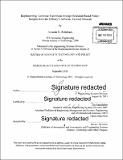| dc.contributor.advisor | Zoe Szajnfarber. | en_US |
| dc.contributor.author | Rohrbach, Amanda K. (Amanda Kaye) | en_US |
| dc.contributor.other | Massachusetts Institute of Technology. Technology and Policy Program. | en_US |
| dc.date.accessioned | 2015-07-31T19:13:38Z | |
| dc.date.available | 2015-07-31T19:13:38Z | |
| dc.date.copyright | 2013 | en_US |
| dc.date.issued | 2013 | en_US |
| dc.identifier.uri | http://hdl.handle.net/1721.1/98003 | |
| dc.description | Thesis: S.M. in Technology and Policy, Massachusetts Institute of Technology, Engineering Systems Division, 2013. | en_US |
| dc.description | Cataloged from PDF version of thesis. | en_US |
| dc.description | Includes bibliographical references (pages 88-91). | en_US |
| dc.description.abstract | Due to a need for congestion relief, as well as a projected increase in capacity constraints, the US Military's Airborne Tactical Network (ATN) is at the onset of a technical transition of their communication hardware and software. While the technical challenges appear to be addressed and agreed upon, the particular challenge lies in navigating the social and organizational challenges of decentralized control, stakeholder misalignment, network externalities, bureaucratic organizational procedures, and limited windows of opportunity. To alleviate these sources of resistance, this thesis proposes an incremental transition strategy that minimizes changes to operational procedures and distributes costs/benefits through schedule-based policy. This research developed a quantitative model to simulate a representative environment of aircraft maintenance routines, flight time, and network usage. Using this model, four incremental strategies were compared including regional, stakeholder-specific, platform-specific, and "big bang" approaches. By evaluating network performance improvements and representative cost profiles, this thesis contends that utilizing an incremental regional or stakeholder-specific strategy is a valid path forward for the ATN transformation. Additional research is necessary; however, to better understand the social dynamics between stakeholders and the relative magnitude of costs associated with each option. This thesis finally presents a 5th incremental strategy utilizing functional increments, which modifies the technical deployment of the systems by staging levels of upgrades sequentially over time. If this is technically viable, the results would distribute lower levels of costs over time and provide enough benefit to account for several years of anticipated growth in network demand. | en_US |
| dc.description.statementofresponsibility | by Amanda K. Rohrbach. | en_US |
| dc.format.extent | 91 pages | en_US |
| dc.language.iso | eng | en_US |
| dc.publisher | Massachusetts Institute of Technology | en_US |
| dc.rights | M.I.T. theses are protected by copyright. They may be viewed from this source for any purpose, but reproduction or distribution in any format is prohibited without written permission. See provided URL for inquiries about permission. | en_US |
| dc.rights.uri | http://dspace.mit.edu/handle/1721.1/7582 | en_US |
| dc.subject | Engineering Systems Division. | en_US |
| dc.subject | Technology and Policy Program. | en_US |
| dc.title | Implementing technical transitions through schedule-based policy : insights from the Military's Airborne Tactical Network | en_US |
| dc.type | Thesis | en_US |
| dc.description.degree | S.M. in Technology and Policy | en_US |
| dc.contributor.department | Massachusetts Institute of Technology. Engineering Systems Division | |
| dc.identifier.oclc | 914492949 | en_US |
